MOSCOW INTERACTIVE
Look at the photos and the titles of the texts. What can you see? What is special about those places?  Listen and read to find out.
Listen and read to find out.

Moscow International Business Centre “Moscow City”
“Moscow City” is a business district consisting of skyscrapers that has been under construction since the mid-1990s. Using the same building methods as some of the world’s leading capitals, such as Paris, the government of Moscow decided to develop a new city centre away from the historical core of the city.
The original plan was to build 23 skyscrapers in total. The twisted Evolution Tower, a complex of skyscrapers called the Federation Tower, the golden Mercury City Tower, the complex City of Capitals - built out of blocks – are just a few of them. Inside the towers there are offices, apartments, hotels, shopping malls, and its underground core has a whole transport hub with three metro stations.
The construction of “Moscow City” has changed the area around it. This area was once full of old factories. Nowadays there are impressive modern buildings.


The Exhibition of Achievements of National Economy (VDNH) is a unique architectural complex and one of the top fifty largest exhibition centres in the world. It opened in 1939 as the All-Union Agricultural Exhibition (VSHV). Over time it had different appearance, ideology and names like the VPV, VDNH USSR and VVC. Originally, the pavilions displayed all the achievements of the national economy of the region and republics. In the 1960s, the pavilions became the industryspecific ones.
Today, the complex has the current name VDNH and its original historical look. You can find many unique architectural masterpieces and grand fountains throughout the site. Pedestrian zones, the largest skating rink in Europe and a giant oceanarium cover one-third of the VDNH. Many popular events and sports festivals take place here. Under the patronage of the mayor of Moscow, Sergey Sobyanin, VDNH continues to develop as the largest cultural exhibition centre and the main public park in Moscow.
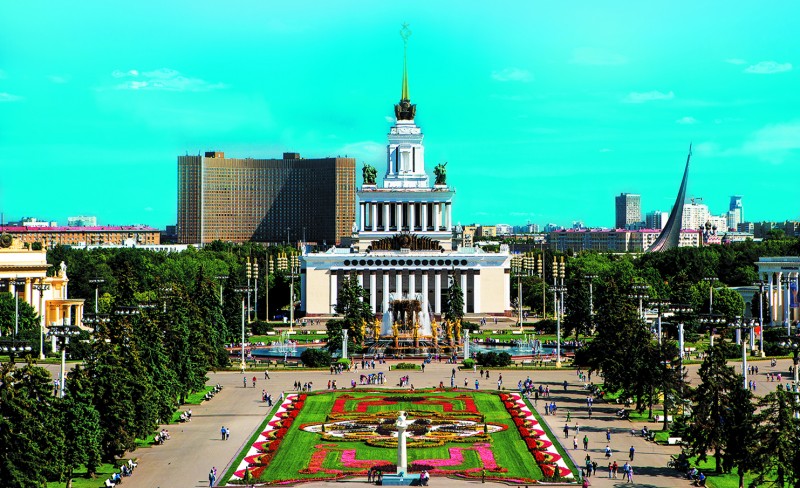
Записать ответ
 Read the texts and write A or B. Which place ...
Read the texts and write A or B. Which place ...
|
1 is an area with really tall buildings? |
AAB |
|
2 had other names in the past? |
AAB |
|
3 is still under construction? |
AAB |
|
4 is ideal to play sports? |
AAB |
|
5 is outside the old city centre? |
AAB |
|
6 now looks the same as in the past? |
AAB |
a)  Use the words business, pedestrian, exhibition, skating, under, transport, architectural, twisted to make phrases.
Use the words business, pedestrian, exhibition, skating, under, transport, architectural, twisted to make phrases.
|
1 district |
5 complex |
|
2 construction |
6 centres |
|
3 tower |
7 zones |
|
4 hub |
8 rink |
b) Use the above phrases to describe the two places.
 Make a list of the things that impressed you in the texts. Write short sentences. Compare with your partner.
Make a list of the things that impressed you in the texts. Write short sentences. Compare with your partner.
Записать ответ

 Collect more information about the skyscrapers in “Moscow City”. Present it to the class.
Collect more information about the skyscrapers in “Moscow City”. Present it to the class.
 What do you usually eat at school? Are there any healthy options? Is it important to eat healthily? Who are behind food preparation in schools in Moscow?
What do you usually eat at school? Are there any healthy options? Is it important to eat healthily? Who are behind food preparation in schools in Moscow?  Listen and read to find out.
Listen and read to find out.

Good nutrition is essential for the health of young Muscovites. A complete and balanced diet helps prevent diseases, improves your physical and mental development. Not only that, it also leads to higher productivity and better progress in school.
Every Moscow school carefully plans the meals for all their students so that they provide all the nutrients students’ bodies need. The aim is to give students a balanced diet, so they use only high-quality products.
Schools also help students form good eating habits for the future. But they can’t do it on their own. After all, a child has breakfast and dinner at home, so parents are responsible for their children’s eating habits, too.
The school and parents cooperate to provide a healthy diet for the children. Schools, health workers and representatives from parent involvement committees also work together to organise school nutrition. Food providers have to meet high standards, and schools must display information about their students’ diets on their websites.
Vadim Krylov, an endocrinologist and a nutritionist, believes that it is very important for schools to cooperate with parents. “We should explain the principles of a healthy diet to pupils as well as to their parents. For example, a glass of fruit juice contains the same amount of calories as a plate of spaghetti with chicken. Furthermore, children are often encouraged to eat sweets. This may lead to obesity. Instead, parents can encourage children to visit a museum, go to the theatre or to a playground,” he notes.
Krylov is right. When schools and parents work together, every student benefits and will have the healthiest future possible.
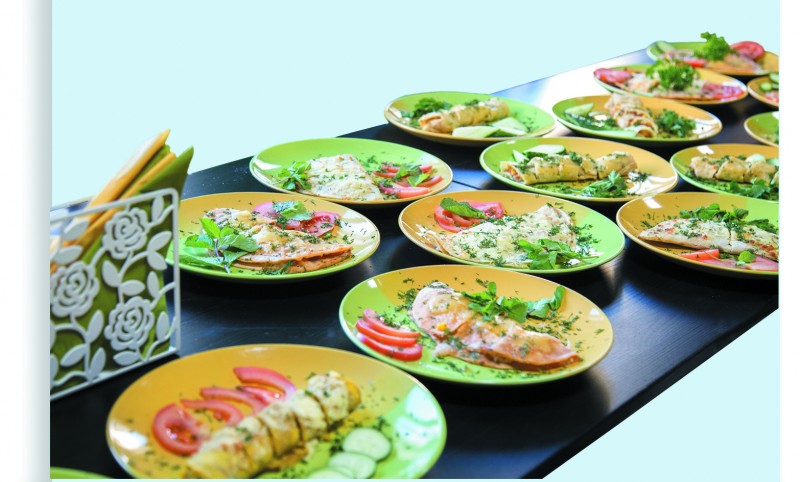
Записать ответ
Read the text and answer the questions.
1 Why is it important to have a healthy diet?
2 What kind of products do schools in Moscow choose for their students’ meals?
3 Why should parents go to school meetings?
4 Who is responsible for school nutrition?
5 What does Vadim Krylov think?
 What do you usually eat at school? Are there any healthy options? Is it important to eat healthily? Who are behind food preparation in schools in Moscow?
What do you usually eat at school? Are there any healthy options? Is it important to eat healthily? Who are behind food preparation in schools in Moscow?  Listen and read to find out.
Listen and read to find out.

 Collect more information about healthy eating. Design your own healthy school menu. Present it to the class.
Collect more information about healthy eating. Design your own healthy school menu. Present it to the class.
Записать ответ
Moscow is famous world wide for its amazing architecture. What do you know about these architects? What else would you like to know? Write a few questions about each one.
 Listen to and read the texts to see if you can answer your questions.
Listen to and read the texts to see if you can answer your questions.

Ivan Zholtovsky (1867—1959)
Ivan Zholtovsky is one of the key figures in the history of Soviet architecture. After the fall of Avant-garde architecture in 1932, he made his main contribution to the history of architecture when he headed an architecture school. The new architectural style was similar to neoclassicism and many of the buildings in Moscow between the 1930s-1950s were built in this style. In many ways, this style created the present look of the city. Zholtovsky contributed heavily to the post-war reconstruction of Russia’s cities. In particular, he advanced the progressive idea of planning city blocks on a large scale with blocks of flats, cinemas and other complexes.
Konstantin Melnikov (1890—1974)
Konstantin Melnikov is one of the most wellknown architects of the 21st century. In his famous Avantgarde projects of the 1920s-1930s he created innovative buildings by experimenting with form, space and lighting. He first became famous worldwide when his exhibits appeared in the USSR pavilion at the 1925 International Exhibition of Modern Decorative and Industrial Arts in Paris. His projects include several unique public buildings in Moscow, such as worker clubs and garages and even his own workshop in Krivoarbatsky Lane which is, even to this day, in the list of the masterpieces of world architecture. It consists of two cylinders that together form a figure 8.
Lev Rudnev (1885—1956)
Lev Rudnev’s greatest project is the impressive Moscow State University located at Vorobyovy Gory (previously known as Lenin Hills). It was built from 1948 to 1953. Thirty-seven buildings in the university campus and the park were constructed at the same time. All the buildings in the university can make up a whole city with a population of 50,000 people. At the centre of the complex there is a 32-storeyed building with a spire which is 240 metres high. Before the 2000s, it was one of the seven Moscow skyscrapers that created the city's skyline. The complex brings to life the neoclassicist spirit of that period. Its characteristics include grand atmosphere, rich interior decoration with lots of details made of marble, glass and bronze, gems (from the Ural region), and valuable species of wood.
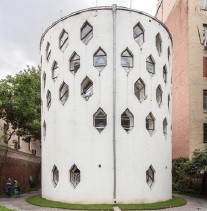
Записать ответ
 Read the text and say if the sentences are T (true), F (false), or NS (not stated).
Read the text and say if the sentences are T (true), F (false), or NS (not stated).
|
1 Ivan Zholtovsky worked in educating other architects. |
TTFNS |
|
2 Ivan Zholtovsky created 25 blocks of flats in Russia. |
TTFNS |
|
3 Konstantin Melnikov designed buildings using ordinary forms. |
TTFNS |
|
4 Konstantin Melnikov’s workshop is one of the best buildings worldwide. |
TTFNS |
|
5 It took Lev Rudnev more than 7 years to build the Moscow State University. |
TTFNS |
|
6 The central building in the campus was Lev Rudnev’s favourite. |
TTFNS |
 It’s Culture Day at your school. Choose one of the architects in the text and make notes about his achievements and work. Present him to the class.
It’s Culture Day at your school. Choose one of the architects in the text and make notes about his achievements and work. Present him to the class.

 Collect more information about famous Moscow architects. Write a short biography. Present it to the class.
Collect more information about famous Moscow architects. Write a short biography. Present it to the class.
Записать ответ
 Where do you usually go on holiday? Would you rather go on holiday to a big city centre or to the countryside? How can you spend your holiday time in a big city centre like Moscow? What places are there to have a really good time at?
Where do you usually go on holiday? Would you rather go on holiday to a big city centre or to the countryside? How can you spend your holiday time in a big city centre like Moscow? What places are there to have a really good time at?  Listen, read and check.
Listen, read and check.
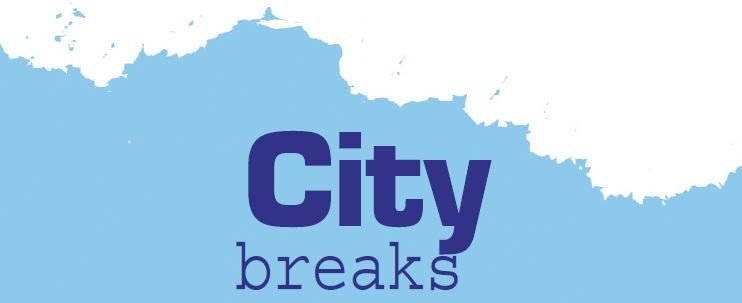
Port at VDNH
What a pleasure it is to relax by the water on a hot day! And you don’t have to be by the sea! Even in Moscow you can find places to swim and to sunbathe. One such comfortable place is at VDNH between pavilions 8 and 9. It’s Port – the largest beach in Moscow.
At VDNH people can find four large pools, jacuzzis, volleyball courts, a stage and a café. In fact, there is everything you need to feel like you’re on holiday! At the weekend, Port even hosts concerts and various events.
Port is a family-friendly place. There are pools for adults and a children’s pool with water slides, one of which looks like a real ship! The water is always warm at about 28°C. There are also comfortable sun loungers by the pools and lifeguards on duty. Sports fans are welcome too. Visitors can work out at the sports ground, or play tennis, table tennis or even mini football. Experienced coaches are on hand to teach everyone how to play water polo, do yoga or dance.
There are even more activities at Port. Twice a week in summer, professional artists teach anyone who wants to learn how to draw! In the centre of Port there’s an oak grove where people can hide from the hot summer sun and relax. They can also listen to music or rest on comfortable sofas by the dance floor. And at weekends there is dancing till morning! The bar has got a variety of smoothies and milkshakes–the best in Moscow!
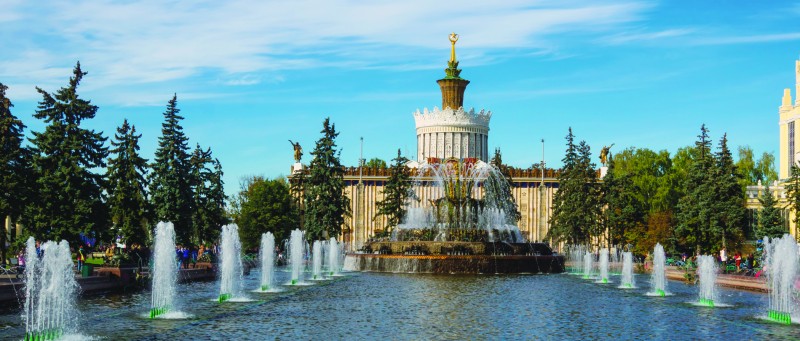
Serebryany Bor
In the North-West of Moscow there is one of Muscovite’s favourite place to relax – Serebryany Bor. It’s a park on the bank of the Moskva River with beaches, cafés, playgrounds and cottages. Every weekend, and often on weekdays, thousands of Muscovites come to Serebryany Bor to swim, play sports or go for walks.
Once it was just an area on the Moskva River where, in the 17th century, people practised falconry. In the 1930s, the Khoroshevskii Canal was built, turning Serebryany Bor into an island with only a bridge connecting it to the land. Later, the area became a campsite where everyone could enjoy the beaches, lake and
beautiful scenery of the landscape.
There are many parks in Moscow, but it’s difficult to find places to swim. Serebryany Bor is where the Moskva River enters the city, so the water here is very clean. This creates a perfect place for beaches.
Today, Serebryany Bor has several beaches. They have everything you need to relax – from sun beds and deck chairs to cafés and restaurants. People can also go kayaking, wind-surfing or play water sports. There are also volleyball and tennis courts. Sometimes, there are musical festivals and beach parties here as well. Some couples choose the place for their wedding. In winter, many people gather here to celebrate the traditional Epiphany ceremony on 19th December.
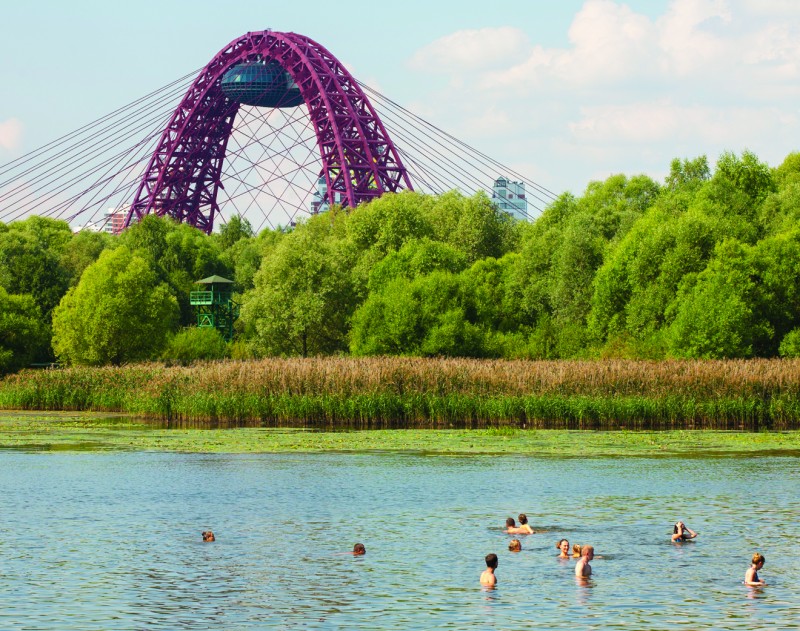
Записать ответ
 Read the texts again and write A, B or both. In which place can you …
Read the texts again and write A, B or both. In which place can you …
|
1 swim? |
AABboth |
|
2 develop your artistic skills? |
AABboth |
|
3 attend a cultural event? |
AABboth |
|
4 attend an important religious celebration? |
AABboth |
|
5 play water sports? |
AABboth |

 Imagine you are at one of these places. Where exactly are you? Who are you with? What are you doing now? What are you planning to do later? How do you feel? Tell your partner.
Imagine you are at one of these places. Where exactly are you? Who are you with? What are you doing now? What are you planning to do later? How do you feel? Tell your partner.
Записать ответ

 Collect information about other popular places in Moscow. Design a leaflet for tourists. Present it to the class.
Collect information about other popular places in Moscow. Design a leaflet for tourists. Present it to the class.
What is special about the Moscow education system? How does it cater for children with special needs?  Listen, read and check.
Listen, read and check.

Moscow schools – open to all children
A good education is one of the best ways for every child – with or without disabilities – to develop social skills. Moscow educational organisations at all levels (preschool, school, vocational and higher education) create special teaching conditions depending on the students’ individual needs.
Almost every big school in Moscow can provide special conditions for teaching physically challenged children. Disabled children who enrol in their local schools can receive a good education and be included in their communities equally with others. Such schools, with students with mixed abilities and special educational needs, do a great job by adopting inclusive teaching methods.
In case a child needs something more than that, Centres of Psychological-Pedagogical, Medical, and Social Assistance serve as resource centres to help every young person continue their studies and develop social skills. For example, if a child has certain learning, medical or social difficulties which in any way stop them from studying, these centres can provide the necessary help.
Moscow: activities for all
In Moscow, disabled children are welcome. They can visit museums, theaters, parks and various places of interest. Moreover, since 2015 the Festival 1+1 has been held in Moscow. The participants are inclusive groups including children and young people with different educational needs aged 3 to 20. Through their creative and artistic work, they can show their various talents and skills in different kinds of art. What is most important about this festival is that it encourages the public to think more about the problems disabled children may have as well as the difficult situations many young people are in. By going to the festival, the public can learn more about these children and how to help them. The highlight of this festival is the final concert which attracts large crowds of people.
Educational practices, public access for all and festivals like this are all good ways to remember one thing: no matter what difficulties you face, you can still achieve great things. And Moscow gets this message across.

Записать ответ
Read the texts again and answer the questions.
1 What options in education are there for disabled children in Moscow?
2 In Moscow, how can children with different kinds of difficulties get more help?
3 What activities are available for disabled children in Moscow?
4 What is the Festival 1+1?

 Tell the class three things that impressed you from the text.
Tell the class three things that impressed you from the text.

 Create another festival similar to Festival 1+1. Think about: name – location – time of year – duration – activities. Present your idea to the class.
Create another festival similar to Festival 1+1. Think about: name – location – time of year – duration – activities. Present your idea to the class.
Look at the photos and the title of the text. How are these names related to this theatre: princess Shakhovskaya – Glebova-Streshneva – Fyodor Kolbe – Konstantin Tersky – Igor Stravinsky – Boris Pokrovsky – Kyrill Tikhonov – Elena Obraztsova – Dmitry Bertman?  Listen and read to find out more.
Listen and read to find out more.
Moscow musical theatre "Helikon-Opera"
Bolshaya Nikitskaya str., 19/16, building 1,2
In 1886, princess Shakhovskaya-Glebova-Streshneva rebuilt the estate to the theatre. Two famous architects worked on the project. Fyodor Kolbe rebuilt the street façade and Konstantin Tersky rebuilt the yard and its façade. The street façade is famous in Europe for its eclectic style and the yard is a wonderful example of pseudo-Russian stylization.
In the 2000s, the reconstruction of the manor began. The original buildings were made larger and, finally, in 2015, the “Helikon-Opera” moved into the new complex. In the courtyard, they built a big hall named after the famous composer Igor Stravinsky. History of theatre begins in 1990. In the 2000s, the reconstruction of the theatre rooms began. The hall can accommodate up to 500 spectators and is similar to a Greek theatre.
During the reconstruction of the theatre, they preserved its historic interiors. At the same time they upgraded the stage with modern stage equipment. They opened more halls in the historic building, all named in honour of important Russian cultural figures. The white-columned hall was named in honour of princess Shakhovskaya-Glebova-Streshneva. The music halls were named after several famous people, like the first conductor of the “Helikon-Opera,” Boris Pokrovsky, the head conductor of the theatre, Kyrill Tikhonov and the legendary opera singer, Elena Obraztsova.
More than 200 performances are held annually in the “Helikon-Opera” under Dmitry Bertman’s supervision.
Interesting facts
• The ceiling looks like the starry sky. Thousands of ceiling lamps and 13 balls, or “helicons,” reflect the sound back into the theatre. This construction creates perfect sound in the auditorium.
• There are LED windows in the walls of the auditorium. During performances, people can see various pictures that create special visual effects.
• There are special platforms in the stage that can rise and fall during performances.
• Today people can enjoy a real bell-ring sound during the performance. Six bells, specially made in Voronezh, are in the backstage.
• They have restored the historic building to make it look like it did in the 19th century preserving its original fretwork and wooden vaulted ceilings.
• The hall named after princess Shakhovskaya-Glebova-Streshneva is famous because Pyotr Tchaikovsky conducted, Feodor Chaliapin sang songs and Alexander Pushkin read his poems in it.
• After the reconstruction, the “Helikon-Opera” has become one of the leading world theatres.

Записать ответ
 Read the text again and complete the sentences.
Read the text again and complete the sentences.
1 The style of the street façade of the Helikon-Opera is .....
2 The name of the big hall in the courtyard is .....
3 During reconstruction the new halls got their names from .....
4 Today more than 200 performances .....

 Read the text again. Make notes of the facts that most impressed you. Compare with your partner.
Read the text again. Make notes of the facts that most impressed you. Compare with your partner.

 Collect more information and interesting facts about Helikon-Opera. Write a short paragraph. Present it to the class.
Collect more information and interesting facts about Helikon-Opera. Write a short paragraph. Present it to the class.